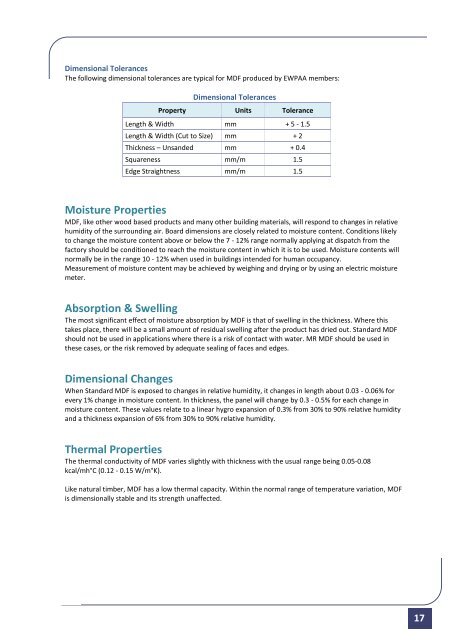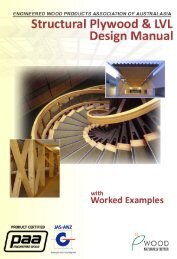Facts About Particleboard and MDF - Engineered Wood Products ...
Facts About Particleboard and MDF - Engineered Wood Products ...
Facts About Particleboard and MDF - Engineered Wood Products ...
You also want an ePaper? Increase the reach of your titles
YUMPU automatically turns print PDFs into web optimized ePapers that Google loves.
Dimensional Tolerances<br />
The following dimensional tolerances are typical for <strong>MDF</strong> produced by EWPAA members:<br />
Dimensional Tolerances<br />
Property Units Tolerance<br />
Length & Width mm + 5 - 1.5<br />
Length & Width (Cut to Size) mm + 2<br />
Thickness – Uns<strong>and</strong>ed mm + 0.4<br />
Squareness mm/m 1.5<br />
Edge Straightness mm/m 1.5<br />
Moisture Properties<br />
<strong>MDF</strong>, like other wood based products <strong>and</strong> many other building materials, will respond to changes in relative<br />
humidity of the surrounding air. Board dimensions are closely related to moisture content. Conditions likely<br />
to change the moisture content above or below the 7 - 12% range normally applying at dispatch from the<br />
factory should be conditioned to reach the moisture content in which it is to be used. Moisture contents will<br />
normally be in the range 10 - 12% when used in buildings intended for human occupancy.<br />
Measurement of moisture content may be achieved by weighing <strong>and</strong> drying or by using an electric moisture<br />
meter.<br />
Absorption & Swelling<br />
The most significant effect of moisture absorption by <strong>MDF</strong> is that of swelling in the thickness. Where this<br />
takes place, there will be a small amount of residual swelling after the product has dried out. St<strong>and</strong>ard <strong>MDF</strong><br />
should not be used in applications where there is a risk of contact with water. MR <strong>MDF</strong> should be used in<br />
these cases, or the risk removed by adequate sealing of faces <strong>and</strong> edges.<br />
Dimensional Changes<br />
When St<strong>and</strong>ard <strong>MDF</strong> is exposed to changes in relative humidity, it changes in length about 0.03 - 0.06% for<br />
every 1% change in moisture content. In thickness, the panel will change by 0.3 - 0.5% for each change in<br />
moisture content. These values relate to a linear hygro expansion of 0.3% from 30% to 90% relative humidity<br />
<strong>and</strong> a thickness expansion of 6% from 30% to 90% relative humidity.<br />
Thermal Properties<br />
The thermal conductivity of <strong>MDF</strong> varies slightly with thickness with the usual range being 0.05-0.08<br />
kcal/mh°C (0.12 - 0.15 W/m°K).<br />
Like natural timber, <strong>MDF</strong> has a low thermal capacity. Within the normal range of temperature variation, <strong>MDF</strong><br />
is dimensionally stable <strong>and</strong> its strength unaffected.<br />
17

















